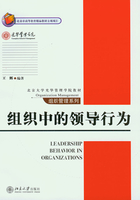
参考文献
[1] 〔美〕史蒂芬·P.罗宾斯,《组织行为学(第七版)》,中国人民大学出版社,1997年版。
[2]《现代汉语词典(修订本)》,商务印书馆,1998年版,第471页。
[3] 凌文辁,“中国人的领导与行为”,《中国人,中国心——人格与社会篇》,远流出版公司,1991年版。
[4] 凌文辁、方俐洛、高晶,“内隐领导理论的中国研究——与美国的研究进行比较”,《心理学报》,1991年第3期,第236—243页。
[5] 罗振宇,“领导与管理的概念应从行为上加以区分”,《领导科学》,2000年第4期,第44—45页。
[6] 毛泽东,《毛泽东选集》第2卷,人民出版社,1991年版,第527页。
[7] 王辉、忻榕、徐淑英,“中国企业CEO的领导行为及对企业经营业绩的影响”,《管理世界》,2006年第4期,第87—96页。
[8] 杨国枢,《家族化历程,泛家族主义及组织管理》,台北:远流出版公司,1998年版。
[9] Bennis, W.G., &Nanus, B., Leaders: The Strategies for Taking Charge, New York:Harper&Row,1985.
[10] Blake, R.R., & Mouton, J.S., The Management Grid, Houston: Gulf Publishing,1964.
[11] Burns, J.M., Leadership, New York: Harper&Row,1978.
[12] Farh, J.L., &Cheng, B.S., “A Cultural Analysis of Paternalistic Leadership in Chinese Organizations”, in J.T.Li., Tsui, A.S., &E.Weldon(eds.), Management and organizations in the Chinese Context, London: Macmillan,2000.
[13] Hofstede, G., Culture's Consequences: International Differences in Work-related Values, Beverly Hills, CA: Sage,1980.
[14] House, R.J., &Howell, J.M., “Personality and Charismatic Leadership”, Leadership Quarterly,1992,3,81—108.
[15] Katz, D., &Kahn, R.L., “Some Recent Findings in Human-relation Research in Industry”, in E.Swanson, T.Newcomb, &E.Hartley(eds.), Readings in Social Psychology, New York: Holt,1952,650—665.
[16] Katz, D., &Kahn, R.L., The Social Psychology ofOrganizations, 2nd ed., New York: John Wiley,1978.
[17] Katz, D., Maccoby, N., &Morse, H., Productivity, Supervision, and Morale in an Office Situation, Ann Arbor, MI: Institute for Social Research,1950.
[18] Kirkpatrick, S.A., &Locke, E.A., “Direct and Indirect Effects of Three Core Charismatic Leadership Components on Performance and Attitudes”, Journal of Applied Psychology,1996,81,36—51.
[19] Kotter, J.P., A Force for Change: How Leadership Differs from Management, New York: Free Press,1990.
[20] Misumi, J., The Behavioral Science ofLeadership, Ann Arbor, MI: University of Michigan Press,1985.
[21] Moore, B.V., “The May Conference on Leadership”, Personnel Journal, 1927, 6,124.
[22] Redding, S. G., The Spirit of Chinese Capitalism, New York: Walter de Gruyter,1990.
[23] Richard, D., &Engle, S., “After the Vision: Suggestions to Corporate Visionaries and Vision Champions”, in Adams, J.D.(ed.), Transforming Leadership, Alexandria, VA:Miles River Press.1986.
[24] Schein, E.H., Organizational Culture and Leadership, 2nd ed., San Francisco:Jossey-Bass,1992.
[25] Silin, R.H., Leadership and Value: The Organization of Large-scale Taiwan Enterprises, Cambridge, MA: Harvard University Press,1976.
[26] Stogdill, R.M., “Personal Factors Associated with Leadership: A Survey of the Literature”, Journal of Psychology,1948,25,35—71.
[27] Stogdill, R.M., Goode, O.S., &Day, D.R., “New Leaders Behavior Description Subscales”, Journal of Psychology,1962,54,259—269.
[28] Tsui, A.S., Wang, H., Xin, K.R., Fu, P.P., &Zhang, L., “Let a Thousand Flowers Bloom: Variation of Leadership Styles among Chinese CEOs”, Organizatinal Dynamics, 2004,33,5—20.
[29] Weber, M., The Theory of Social and Economic Organizations, translated by Parsons, T., New York: Free Press,1947.
[30] Westwood,R.I.,&Chan,A.,“Headship and Leadership”,in: Westwood,R.I. (ed.),Organizational behavior: A Southeast Asian Perspective, Hong Kong: Longman Group,1992,123—139.
[31] Westwood, R.I., “Harmony and Patriarchy: The Cultural Basis for ‘Paternalistic Headship' among the Overseas Chinese”, Organization Studies,1997,18,445—480.
[32] Yang, K.S., Yu, A.B., &Yeh, M, H., “Chinese Individual Modernity and Traditionality: Construct Definition and Measurement”, Proceedings ofthe Interdisciplinary Conference on Chinese Psychology and Behavior,1989.
[33] Yukl, G., Leadership in Organizations,北京:清华大学出版社,2001年版。